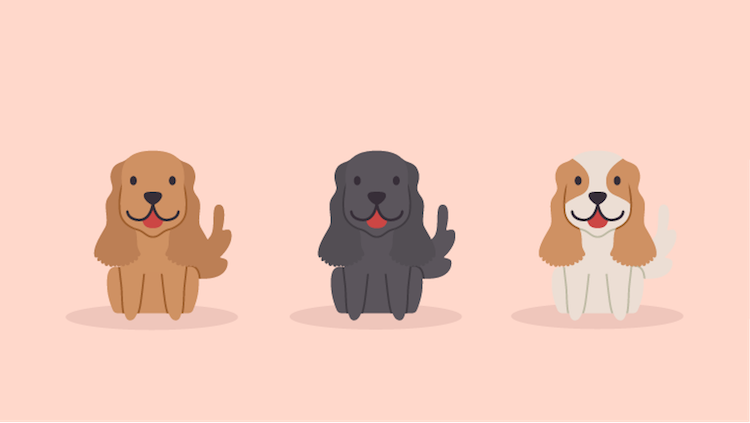Both Springer Spaniels and Cocker Spaniels were originally bred for hunting, and these days they’re more commonly found as loveable family pets. Known and recognisable wherever they go by their famous long, hairy, Spaniel-esque ears, Springer Spaniels and Cocker Spaniels can sometimes be difficult to tell apart. If you’ve ever found yourself wondering which is which, read on to discover some helpful hints for telling these dog breeds apart.
Springer Spaniel vs Cocker Spaniel history
Both Springer Spaniels and Cocker Spaniels can trace their heritage back to Spain, as their names suggest! They’re an ancient breed with plenty of history to match their large personalities. They first pop in the history books when the Romans chose Spaniels to be their companions on trading ships, then a few centuries later in Welsh legal documents written around 300 AD. Dogs that closely resemble today’s Springer Spaniels are depicted in artwork from the 16th and 17th centuries.
Springers owe their name to their skills which came in handy during game hunting. They were first used even before guns were invented to flush game birds or small animals by ‘springing’ on them (which is why they’re dubbed “Springer”) and driving them into the open to be caught in the huntsman’s nets.
In the 19th and early 20th century England, Spaniels were classified as Gun Dogs by their hunting use. Smaller Spaniels that were used to hunt woodcock got the name Cockers, while larger dogs were used to flush game and were called Springers.
The Cocker Spaniel was recognised as a breed in England in 1892 and In 1902, the English Kennel Club recognised the English Springer Spaniel. Both breeds gained popularity very quickly with both breeders and the public.
Springer Spaniel vs. Cocker Spaniel appearance
There’s no question that Springer Spaniels and Cocker Spaniels look very similar with their gentle expressions, floppy ears and curly hair.


There are some differences though. Springer Spaniels are medium sized dogs with bodies that are longer than they are tall. They also have shorter, higher set ears and a longer muzzle than a Cocker Spaniel.


Cocker Spaniels are similar in appearance to Springer Spaniels, just a bit smaller. Plus, a Cocker Spaniel’s coat tends to be fluffier and fuller. A Cocker Spaniel’s tail is naturally thick and then tapers at the end. It usually doesn’t reach below the hock joint on their leg. Springer Spaniel’s tails are slightly longer and are more thickly boned.


Springer Spaniels weigh between 20-25 kg and approximately 45-56 cm tall. Male Cocker Spaniels are about 38 cm tall whilst females are 35 cm tall. Both male and female Cocker Spaniels weight between 10-13 kg.


Springer Spaniel vs. Cocker Spaniel coat
Springer Spaniels have a double coat – the top coat is medium length and flat or wavy and the undercoat is short, soft and dense. They have feathering and long fringes of hair on their ears, chest, legs and belly, and their coats are waterproof, weatherproof and thornproof.

According to the Kennel Club Breed Standard, the current registered colours for Springer Spaniels are black, or a deep reddish brown, with white markings or white with black or liver markings. Springers bred for show tend have more colour than white whilst Working Springers have more white on their coat so hunters can see their dogs more easily.
Springer Spaniels shed a moderate amount all year round so to keep it to a minimum and prevent their hair from getting matted or tangled, it’s best to regularly brush your Springer at least three times a week. They may also need their hair trimmed around their neck, ears, tail and feet where their hair is more curly and feathery. This can be done by a groomer every three months.
The Cocker Spaniel has a thick, wavy coat that’s short on the head and back and long on the ears, chest, belly and legs.

According to the Kennel Club Breed Standard, Cocker Spaniels have many more colour variations than their Springer cousins. Cockers’ colourings can range from solid colours including black, light cream, red or brown or in two or more colours mixed with white. So one way to tell Cockers and Springers apart is if you spot a medium sized Spaniel which is a solid chocolate or black, you’ve stumbled across a Cocker!
Cocker Spaniels require a lot of grooming. Daily brushing is necessary to avoid tangles and matting and it’s recommended that you have your Cocker Spaniel professionally groomed, bathed and brushed every six to eight weeks.
What’s the difference between a Working and a Show Springer Spaniel?
A Working Spaniel is bred for working in the field, whilst other Spaniels are bred as show dogs. Springers have been bred separately for over 70 years so they can be very different dogs.
Working Spaniels have more of an athletic build than Show dogs, and they also weigh less, too. Plus, they have shorter coats, their noses are pointier and they ears are shorter. Show Springer Spaniels have longer hair, a square muzzle and longer ears.
Working Springers are known for their ability to hunt, their sense of smell and trainability. Show Springers can still hunt but they are bred more for their good looks!
Both dogs need a lot of exercise but Working Springers will tend to have more energy than Show Springers.
Springer Spaniel vs. Cocker Spaniel Health
Both breeds are prone to ear infections because of their floppy ears so they need to be checked and cleaned regularly. There are special food bowls that are deep and narrow that the Springers and Cockers can use without getting their ears wet.
Both breeds are generally healthy but they’re still prone to some health conditions. Cocker Spaniels can suffer from eye problems like cataracts or glaucoma, and are prone to allergies or skin conditions. They can also have hypothyroidism, epilepsy and hip dysplasia. Springers can also suffer from hip dysplasia, hypothyroidism and von Willebrand’s disease. Like Cockers, Springers can have various eye problems and skin conditions.
Springer Spaniel vs Cocker Spaniel personality
Springer Spaniels and Cocker Spaniels are both very affectionate, sweet-tempered dogs.
Cocker Spaniels are sensitive dogs with a soft personality – this means they can become nervous, and if they’re afraid they may snap or growl. Patient training will bring out the best of your Cocker Spaniel’s personality.
Cocker Spaniels are suited to live in flats or apartments as they don’t need a lot of space. They do love to roam so a house with a garden would be preferred where possible. They don’t need a lot of exercise but are known to misbehave when they’re bored – if you neglect your Cocker you might find that they’ve taken to barking, digging or chewing things. They also love the companionship of a family and may show signs of separation anxiety if left alone for long periods.
Cocker Spaniels aren’t just good looking – they’re natural hunters, can be very obedient and have strong agility and tracking skills.
Springer Spaniels don’t need a lot of living space either but they will need more exercise than a Cocker Spaniel. They love to roam and will do their own thing then check back with you whilst you’re in the garden, the same as they would if they were on a hunt. Springers also love to swim and it’s a great way for them to get exercise.
Springer Spaniels are fast learners and easy to train. They also have strong tracking and agility skills.
Do Springer Spaniels and Cocker Spaniels make good family dogs?
Cocker Spaniels make excellent family dogs and can get along with children well. Cocker Spaniels will also be friendly with other family pets like dogs, cats and smaller animals, too. It’s best to socialise your Cocker Spaniel as a puppy so they make friends with everyone early on.
Springer Spaniels are also good family dogs and will live happily with children especially if they are introduced as puppies. They’re probably more suited for older children who know how to interact with dogs well.
They are also good with other pets like dogs and cats but may look at birds as prey rather than mates.
Do you prefer the Springer Spaniel or Cocker Spaniel? Share with us on Facebook, Twitter or in comments below.